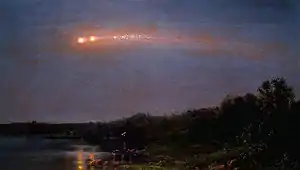掠地火球
掠地火球(Earth-grazing fireball),或稱掠地小天體[2]是進入地球的大氣層而又再離開的太陽系小天體。如果它在大氣層內開始破碎,它可能成為掠地流星串,並且有一些碎片可能會撞擊到地球[1],著名的例子是1972年白日大火球和1860年7月20日的流星列[1][3][4]。

弗雷德里克·雀屈(Frederic Church),"1860年的流星"。在150年後的2010 年,它被確定為掠地流星列[1]
通過大氣層的掠地天體,它的質量和速度都會改變,因此當它再回到太空時,它的軌道也會改變[5][6] [7]。
通過地球的大氣層沒有明確的標準,或許在80公里(50英里)以上,或是在卡門線的100公里(62.1英里)。高層的大氣沒有明確的界限,只是逐漸變得稀薄,從平流層(~50公里)、中氣層(~85公里)、熱成層(~690公里)、直到散逸層(~1,000公里)(參見熱成層頂)。例如,流星體在地球上空85-120公里的高度上成為流星。
掠地小天體或內掠這個名詞,有時也用在軌道靠近地球的小行星或流星體(像是距離接近到少於月球距離)。一顆太陽系小天體的掠地軌道不一定要與地球的大氣層接觸,然而也可能會與地球碰撞(參見近地小行星列表和Outer-grazer)。
已知的掠地火球
掠地火球是很罕見和很少被測量的一種火球[8],是流星體與地球的大氣層碰撞,並且在之後還能存在著再離開造成的。迄2008年,有4顆掠地火球被科學性的觀察[9]。
- 1860年大流星:被畫家弗雷德里克·雀屈(Frederic Church)畫下,並被華特·惠特曼在詩中描述,至2010年才被認定是掠地火球[1][3][4]
- 1913年2月9日流星串:可能原自地球捕獲的一天然衛星碎裂[10]。
- 1972年白日大火球:US19720810在美國和加拿大上空以每秒15公里的速度掠過(第一顆被科學性觀察)。
- 1990年10月13日掠地流星體:一顆質量40公斤,以每秒41.5公里的速度,97.9公里的高度從捷克斯洛伐克上空掠過[7]。
- 2006年3月29日:一顆火球以每秒18.8公里、71.4公里的高度掠過日本上空[11][12]。
- 2007年8月7日:EN070807通過,軌道是罕見的阿登型小行星 [8][13]。
參考資料
- http://www.txstate.edu/news/news_releases/news_archive/2010/06/YearOfMeteors060110.html
- http://antwrp.gsfc.nasa.gov/apod/ap090302.html
- Images of Harper's Weekly front page story
- 150-year-old meteor mystery solved 的存檔,存档日期2010-06-05.
- US19720810 (Daylight Earth grazer) 的存檔,存档日期2004-03-07. Global Superbolic Network Archive, 2000, 'Size: 5 to 10 m'
- Daylight Fireball of August 10, 1972 C. Kronberg, Munich Astro Archive, archived summary by Gary W. Kronk of early analysis and of Zdenek Ceplecha's paper for Astronomy and Astrophysics in 1994, '3 meters, if a carbonaceous chondrite, or as large as 14 meters, if composed of cometary materials', 'post-encounter ... 2 or 10 meters'
- Spurny', P.; Ceplecha, Z.; Borovicka, J. Earth-grazing fireball: Czechoslovakia, Poland, October 13, 1990, 03h27m16sUT. WGN, Vol. 19, Nr. 1, p. 13; (aphelion of its orbit changed from 2.80 AU to 1.80 AU)
- P. Spurný, J. Borovička, Z. Ceplecha and L. Shrbený, Astronomical Institute of the Academy of Sciences, Fričova 298, CZ-251 65 Ondřejov Observatory, Czech Republic Precise Multi-instrument Data on 45 Fireballs Recorded over Central Europe in the Period 2006-2008. Retrieved 2008-07-06
- Although other grazers have been seen and, rarely, photographed, without specialised scientific observations their orbits cannot be determined. An example is the Leonid grazer over Hawaii in 2001-11-18 -Abe 2006 (PDF)
- O'Keefe, John A. 1959. A Probable Natural Satellite: The Meteor Procession of February 9, 1913. Journal of the Royal Astronomical Society of Canada, Vol. 53, p.59. Code 1959JRASC..53...59O. Retrieved 2008-07-07
- Abe 2006 (abstract)
- Abe 2006 (PDF) approximately 100 kg, orbit aphelion reaches Jupiter
- EN indicates the European Fireball Network
外部連結
- Fireball of 1972
- Fireball of 1860 (painting)
This article is issued from Wikipedia. The text is licensed under Creative Commons - Attribution - Sharealike. Additional terms may apply for the media files.
